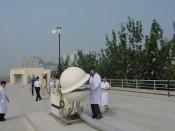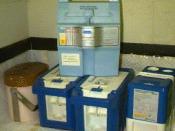Nuclear medicine is a vital part of the emerging molecular imaging industry, in which non-invasive techniques are used to determine the diagnostic information about the functionality of specific organs and areas via radioisotopes. The use of radioisotopes in nuclear medicine is to either aid diagnosis or for therapeutic use in treatment of disease. A few of the areas covered in this speech are the production of radioisotopes used, the use of radiopharmaceuticals, diagnosis imaging, radioisotope selection criteria, and radiation dose.
Most radioisotopes used in nuclear medicine are produced in nuclear reactors. The radioisotopes are produced by bombarding a stable isotope of a substance with neutrons creating a radioactive isotope of that original stable isotope. This process is called fission. For example, Iodine-131, which is useful in nuclear medicine, is produced in a thermal nuclear reactor by a rod of the element Tellurium-130 which is bombarded by slow-moving neutrons forming the unstable isotope Tellurium-131.
The Tellurium then undergoes spontaneous decay that results in the production of Iodine-131. After a period of approximately thirty days the rod is removed and the Tellurium and Iodine are chemically separated.
Another example is the production of Technetium-99m which used in approximately 82% of the nuclear medicine procedures in the world. It is the semi-stable daughter nucleus of a fission product called Molybdenum-99. Molybdenum-99 is produced at Lucas Heights, near Sydney, in a nuclear reactor. Each week some of Molybdenum is taken to hospitals that have a technetium generator. This generator, often called a 'moly cow', consists of a central alumina column which the Molybdenum is chemically bonded to. It undergoes beta decay and Technetium is formed on the outer. A saline wash is poured over the technetium and it separates off, collecting the solution in a syringe, now containing concentrated technetium and can...


